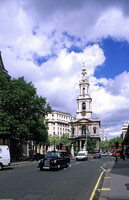Saint Mary-le-Strand
Gibbs, James

Download1A1-GJA-SMS-A1_cp.jpg (463.2Kb)
Alternative Title
St. Mary-le-Strand
Date
1714-1717Description
Context view, showing the front elevation and tower; Gibbs held a post as surveyor to the Fifty New Churches Commission in London. In this capacity he designed the church of St. Mary-le-Strand, but the death of Queen Anne in August 1714 caused an apparent setback. The Tory–Jacobite taint led to Gibbs’s dismissal when the Commission was re-formed in December 1715. By this time a rival Scottish architect, Colen Campbell, was intriguing against him, putting it about that Gibbs was a disaffected papist and attacking (in the preface to Vitruvius Britannicus, i, 1715) the Italian Baroque masters who had formed his style. Gibbs denied Campbell’s accusations (though in fact he remained a covert Catholic to the end of his life) and persuaded the Commission to let him complete St Mary-le-Strand. The cosmopolitan sophistication of the church in The Strand established Gibbs’s credentials at a time of considerable flux in English architectural taste. Although he was denied further advancement in the Office of Works, owing to its progressive Palladianism, his Tory and Scottish admirers ensured that he did not lack commissions. Source: Grove Art Online; http://www.oxfordartonline.com/ (accessed 7/18/2010)
Subject
architecture, City planning, Eighteenth century, Neoclassical, Palladian
Rights
Rights Statement
Licensed for educational and research use by the MIT community only